Ascension
You may have seen this on the evening news. The setting is a graduation, a wedding, an elementary school. A father who has been away from home for a long time has returned home secretly and waits out of sight, unknown to his child, who believes that his Dad is still away. And, at the perfect moment, Dad comes out of hiding. Cameras roll as the unsuspecting child recognizes him and runs to embrace him, tears of joy streaming down his face.
 Can it have been any different for Jesus when he returned home to perfect union with His beloved Father? Separated from Him and clothed in flesh for 33 years, Jesus struggled with the human limitations of His followers as He did His best to reveal to them His own identity and that of His Father. He cried over the coming destruction of Jerusalem and the death of His friend Lazarus. He dealt with exhaustion, hunger, thirst and rejection (“Will you also leave me?”). The Transfiguration most certainly revealed Jesus’ glory to Peter, James and John, but did it not also console Jesus and strengthen him for the terrible ordeal that was to come?
Can it have been any different for Jesus when he returned home to perfect union with His beloved Father? Separated from Him and clothed in flesh for 33 years, Jesus struggled with the human limitations of His followers as He did His best to reveal to them His own identity and that of His Father. He cried over the coming destruction of Jerusalem and the death of His friend Lazarus. He dealt with exhaustion, hunger, thirst and rejection (“Will you also leave me?”). The Transfiguration most certainly revealed Jesus’ glory to Peter, James and John, but did it not also console Jesus and strengthen him for the terrible ordeal that was to come?
And now, all was accomplished. He was going home.
In the paintings of the Ascension done by the great masters, we see Jesus, human body glorified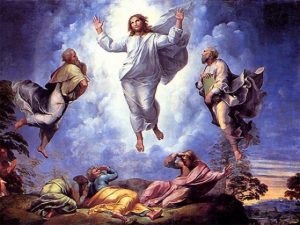 and healed, surrounded by the angels and the glory of heaven. The clouds are painted with beautiful shades, the Father is seated on a glorious throne, the prophets and saints are present and clothed in splendor, and the light streams from above and falls on all who are witnessing the scene of Christ’s return. But the greatest wonder of this event cannot be captured by any human work of art. Jesus and His Father are reunited in perfect love. And their home will also be our home someday.
and healed, surrounded by the angels and the glory of heaven. The clouds are painted with beautiful shades, the Father is seated on a glorious throne, the prophets and saints are present and clothed in splendor, and the light streams from above and falls on all who are witnessing the scene of Christ’s return. But the greatest wonder of this event cannot be captured by any human work of art. Jesus and His Father are reunited in perfect love. And their home will also be our home someday.
Welcome home Jesus. Draw us after you!
~by Sister Eileen Dunbar, OSB
Continue ReadingAqua/Hydroponics Training
Is summer’s heat squashing your energy?
Plan ahead for our next really cool aquaponics training in the fall.
October 17 through 21, 2022
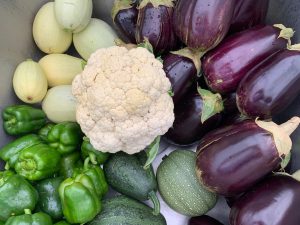 Here at Holy Name Monastery in Saint Leo, Florida we have been engaged in aquaponics farming since 2015. We have cultivated a wide variety of fresh vegetables and raised thousands of tilapia using the best farming practices of aquaponics. Plan now to experience the thrill of growing your own food and register for this life-changing course. You will develop skills necessary for the creation of a sustainable backyard aquaponic system, a system that will contribute greatly to your family’s well-being. Let Aquasol help you design your healthy food future.
Here at Holy Name Monastery in Saint Leo, Florida we have been engaged in aquaponics farming since 2015. We have cultivated a wide variety of fresh vegetables and raised thousands of tilapia using the best farming practices of aquaponics. Plan now to experience the thrill of growing your own food and register for this life-changing course. You will develop skills necessary for the creation of a sustainable backyard aquaponic system, a system that will contribute greatly to your family’s well-being. Let Aquasol help you design your healthy food future.
TOPICS COVERED:
Classroom: Introduction, benefits of aquaponics, types of aquaponics, home food production, commercial, social, mission aquaponics around the world, vegetable choices, biological and natural pest control, fish biology, fish nutrition, fish selection, fish food and feeding, water quality, nitrification and nutrient availability for plants, good agricultural practices and best aquaculture practices.
aquaponics around the world, vegetable choices, biological and natural pest control, fish biology, fish nutrition, fish selection, fish food and feeding, water quality, nitrification and nutrient availability for plants, good agricultural practices and best aquaculture practices.
COURSE DETAILS:
Length: 5 days with optional evening seminars
Materials: include course manual, hands-on activities
Cost: $990 per person
Registration: 813-600-9297 or email don@aquasol.org
Email Don Luttrell: don@aquasol.org or click on the link below for their website.
www.Aquasol.org
(click on the link above)
Continue ReadingUpdate from the Benedictine community in Lviv, Ukraine
The situation with the reception of refugees remains intense. People from the eastern regions of our country continue to arrive here and seek refuge. Most of them managed to escape the bombardments by evacuation trains or green corridors and have already witnessed the explosions. They are often very stressed and need to be taken care of.
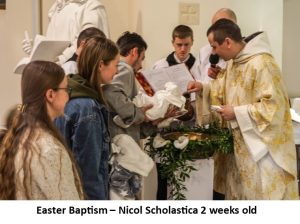 On the day of the Lord’s Resurrection, there are 117 people (44 of them children) in our monastery without monks and nuns (139 in total). We were able to increase the number of beds a little and create a more comfortable stay for them. In total, more than five hundred people during this period asked to stay overnight or stayed at the monastery for some time. Now we have mostly families who are permanent and don’t want to go any further. With
On the day of the Lord’s Resurrection, there are 117 people (44 of them children) in our monastery without monks and nuns (139 in total). We were able to increase the number of beds a little and create a more comfortable stay for them. In total, more than five hundred people during this period asked to stay overnight or stayed at the monastery for some time. Now we have mostly families who are permanent and don’t want to go any further. With some of the families we developed a warm and friendly relationship, they quickly became part of our family. At the Easter Vigil there was the Baptism of our youngest resident, Nicol Scholastica, who was only two weeks old at the time of her arrival.
some of the families we developed a warm and friendly relationship, they quickly became part of our family. At the Easter Vigil there was the Baptism of our youngest resident, Nicol Scholastica, who was only two weeks old at the time of her arrival.
Thanks to your help we can take these people in and give them everything they need, and we are infinitely grateful that you are sympathetic to our suffering and that you are close to us in such a concrete way.
The Benedictine Sisters of Florida and our donors have contributed to the refugee relief.
We thank you for your loving support to the Sisters and their missions!
Continue ReadingMother’s Day
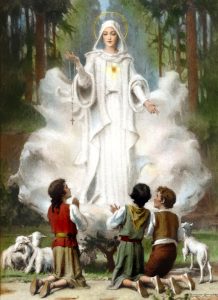 One of the lovely, but often misunderstood, elements of our Catholic religion is our devotion to Mary, the Mother of God. The Hail Mary is among the earliest prayers many of us learned, often from our mothers’ lips as our tired heads hit the pillow at night, or as the family gathered for the nightly recitation of the Family Rosary. Some of you may have grown up in the time close to the 50th anniversary (1967) of Mary’s appearance to the children at Fatima. There was a traveling statue that migrated from parish to parish. This practice was revived in 2017 during the 100th anniversary year.
One of the lovely, but often misunderstood, elements of our Catholic religion is our devotion to Mary, the Mother of God. The Hail Mary is among the earliest prayers many of us learned, often from our mothers’ lips as our tired heads hit the pillow at night, or as the family gathered for the nightly recitation of the Family Rosary. Some of you may have grown up in the time close to the 50th anniversary (1967) of Mary’s appearance to the children at Fatima. There was a traveling statue that migrated from parish to parish. This practice was revived in 2017 during the 100th anniversary year.
But, why talk about that today? It was the description in the Gospel of a good shepherd. You have heard that in ancient Israel, and even today particularly in South America, “good shepherds” are women. In my office hangs a picture of the La Divina Pastora (note the final letter connoting a feminine shepherd). Jesus says: “My sheep hear my voice; I know them.” Doesn’t that sound like a mother on alert for the cries of her child at all hours of the day or night? So, this being Mother’s Day weekend gives me an opening to reflect on devotion to Mary, Mother of our Savior. It’s a heart-connection: a non-threatening, “she-understands-me” sort of relationship. Stories of her miraculous appearances to people “just like us” fill us was with awe and a desire for closeness to Mary. [A Catholic calendar lists a different Marian commemoration for each day of the year.] We marvel at the believer’s relationship with Mary that naturally blends with their relationship with her Son, Jesus. We trust her instincts. We plead with her to “hold open the back door of heaven” for us. And (here at the monastery) we remind Mary each evening “never was it known that anyone who sought your intercession was left unaided.”
To borrow words of praise on Mary from S. Joan Chittister: “Mary is not simply “Mary, the Mother of God.” No, on the contrary. The Mother of God is the image of women everywhere. The Mother of God is Mary, independent woman; Mary, the unmarried mother; Mary, the homeless woman; Mary, the political refugee; Mary, the Third World woman; Mary, the mother of the condemned; Mary, the widow who outlives her child; Mary, the woman of our time who shares the divine plan of salvation; Mary, the bearer of Christ. Mary shows us the sanctifying power of a human being who has become fully human.” [Joan Chittister Women of Strength 2020]
It’s hard to explain in human words what a relationship with Mary means to me. I grew up in a parish where the pastor had GREAT devotion to our Lady. His voice softened when he spoke of her. He led his parishioners in a variety of devotional practices like May processions and crowning of statues, the living rosary in October and the practice of the Family Rosary. I’ve heard many converts to Catholicism say (in so many words) that it was through a loving relationship with Mary that they were encouraged to seek more information that eventually led them to enroll in an RCIA program … which led to their reception into the Church.
We echo the words of the angel’s greeting to Mary each time we pray the Hail Mary. Jesus’ cousin, John the Baptist, the unborn child in Elizabeth’s womb, is said to have recognized the presence of the Lord and leaped for joy. His mother Elizabeth is the “amazed saint” recognizing the unique blessedness of Mary. The attitude of Elizabeth is representative of the attitude we aim to emulate.
When Jesus was 12-years-old his parents, Mary and Joseph suffered the awful experience of losing a child. When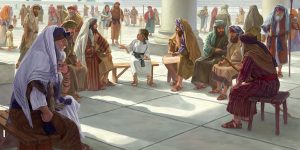 they found him in the temple, “sitting among the teachers, listening to them and asking them questions” the only satisfaction they got from him was that he had to be about his Father’s business. Many have thought his words to be disrespectful but if you know 12-year-olds they sound pretty typical. At 12, every Jewish boy was expected to make his bar mitzvah and become a responsible subject of the law. Jesus says that he was never lost; he was at home; He was in his Father’s house.
they found him in the temple, “sitting among the teachers, listening to them and asking them questions” the only satisfaction they got from him was that he had to be about his Father’s business. Many have thought his words to be disrespectful but if you know 12-year-olds they sound pretty typical. At 12, every Jewish boy was expected to make his bar mitzvah and become a responsible subject of the law. Jesus says that he was never lost; he was at home; He was in his Father’s house.
The most puzzling part of the story, however, is the way it ends: “Then he went down with them and came to Nazareth, and was obedient to them”. The puzzle is this: If Jesus, already at the age of twelve, was ready to begin his public mission, and was evidently well prepared for it, why would he go down with his parents and spend the next eighteen years in the obscurity of a carpenter’s shed? He only began his public ministry at the age of thirty when the supply of wedding wine ran out. Mary jump-started his ministry with her directive to the servants – “Do whatever he tells you.”
When we reflect on the fact that for every one year of his public life Jesus spent ten years in family life, then we can begin to understand the importance and priority he gave to family life. And, now you may have a clue why I chose to speak of Mary on this Mother’s Day weekend. Maybe you, too, learned the simple prayer that begins: Lovely Lady, teach me how to pray; God was just your little boy, and you know the way.
~Reflection by Sister Roberta Bailey, OSB
Continue Reading




